David Barron's Blog, page 8
July 24, 2011
How to Write a Book

Not pictured: Writing
Rule One: drink AFTER you write.
If this were How to Write a Short Story, I'd be all for drinking while you write. You're trying to finish as fast as possible, so you need an outside clock to race against. In this case, that clock is drunkeness. Try it with speed chess! (On no circumstances should you drink before you write. That never helps.) With books, though, you've got to pace yourself. Unless you've hit the Next Level or are on drugs, you're probably not going to finish the book in one day. So, put the beer aside until you've got at least 2000 words done that day.
Rule Two: Set a deadline!
Make it arbitrary, but realistic (you know how much you write), then generate an 'expected wordcount per day'. Buy a wall calendar or some sort of annoying computer program that counts the days for you and yells at you. For my current series, I'm giving myself 25 days for each short book, at 1000 words a day. Obviously, some days I write 500, some days I write 2000, and one day (this is a Certainty) I write 5000 words. Whatever you set, just do it or you're not a Writer, and stop calling yourself one. It makes the rest of us look bad.
Rule Three: Don't think about the book too much unless you're writing it.
Write in the morning, Play in the afternoon, Write in the evening
Sleep
Repeat
Note: It doesn't count as 'play' if you're thinking about work.
Rule Four: Race yourself!
Set a 15-minute timer and type. See how many words you can type, then try again. Mark your highest. FocusWriter has a convenient timer that'll give you a wordcount at the end. Neat!
Rule Five: Bracket Outline
When I start a book, I usually write the first chapter without knowing what's going to happen, then I take whatever characters and plot developed from that and come a bracket outline. Each bracket can be a scene, a chapter, a plot twist, or just a cool 'image', but the point is that you're supposed to expand them and 'explode' words out of the bracket. Anything not in brackets can be weaved into the dialogue. (I'm sure there's a way to make the wordcounter ignore anything between [X], but I'm too lazy to deal with it) Here's an example of a short bracket outline after a first chapter introducing Jimmy Bats, hapless used car salesman:
Jimmy Bats was a man disappointed with his car lot in life. [&c]
[Jimmy Bats loses his keys]
[A global key theft ring?]
[Meet Cute: Darlene, the key detective]
[A Comic Interlude; polka dot dress]
[Murder by Car]
[Jimmy Bats Finds A Clue amidst the wreckage, leads to the Smithsonian's Janitor Closet]
[The Declaration of Keydepence?]
[Darlene kidnapped!]
[Jimmy kicks Ass. (...keyster?)]
[A Wedding and a brand new car]
"Oh, Jimmy! You DID have the keys to my heart!"
THE END
###
Now just write it, rolling through the brackets and expanding them as far as they'll go, adding new brackets as you see the need so you always know what you'll be writing tomorrow. I usually come up with about ten brackets before I start, not worrying too much how to tie them all together. They'll all come together somehow, if you just force yourself to write about it. (The title of the book is "Christmas and Keyster". And if you write it, you can keep it.)
Rule Six: Don't read the book until you finish the book.
It can't be judged as a book until it's done. It probably doesn't suck as much as you think it does.
Rule Seven: [Redacted]
[It was about sex.]
Rule Eight: Buy My Book, I guess?
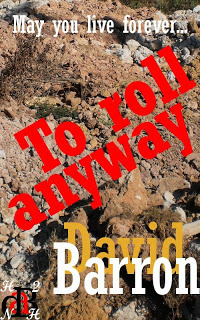
May you live forever...
Ernie Centrifuge just wants to relax with his girlfriend (a police inspector) and play with his survey drones, but when a Senator is assassinated by laser, Ernie decides that the floating city isn't as relaxing as he would have hoped. When his sister (a psion) brings in an orphan girl who found a tantalizing map, Ernie decides to descend to the surface of a forgotten Earth. But what has he left behind on Megalopolis?
A technological thriller with a double shot of humor and romance: To roll anyway, a science fiction short novel by David Barron.Available Stories


Published on July 24, 2011 22:54
July 17, 2011
Like Unto a Rubber Tree is the Business of Writing
Folk hereabouts have rubber tree farms. Now the interesting thing about these trees is that before you can get any rubber out of them worth anything, you've got to plant the trees and grow them for five years until they're ripe, then you can harvest the rubber and sell it steady for the next thirty years, and then you cut down the trees and make some really nice furniture. Some owners just hire people to harvest and sell the rubber in exchange for forty percent of the profit while they sit in the house counting their sixty percent. Or they plant some more rubber trees. It's a good life.
So, what's my point? Calm down, writer guy. It's too hot. Work in the shade, stop looking at your sales numbers. You're getting all anxious over something that ain't ripe yet. Add to it, it's lonely. Don't even think about quitting for at least five years, and don't huff the fertilizer you should be using to tend it and make it grow.
BAM! Spreadsheet --
Here's a real basic spreadsheet. You can make it too, so long as you know where to find the SUM function in Excel. I'd make it interactive, but I'm super lazy. It's all monthly, and I've set it up to do all the royalty math (using Amazon's setup). At the top I input my basic minimum income, and included an hourly wage based on that. All that done, I just input how many of each product H2NH has at the moment and see what happens. This leads to two basic conclusions:
I don't have enough rubber trees.
I need more titles to get to my basic minimum income, unless the lighning strike of sudden popularity hits me in the business (read: Magic! Fairy Dust! Bubble!). I can play with the numbers and see exactly how much more I'd have to write to get to my basic minimum income, but the inescapable conclusion is "I should write more." Getting this result is a good test of any Writer's Business Plan.
My rubber trees ain't ripe.
For the average monthly sales, I input the "scraping-the-bottom" benchmarks culled from Dean Wesley Smith's various series. Right now I only have actual data for my short stories, and it's a number that's a little less than 2. Then again, the reason I only have actual data for short stories is that I've only been doing this for six months. That's kinda the point. Nobody cares about a field of six-month rubber trees except some random people who happen to notice it while they're walking down the highway. You can't even sit under a six-month rubber tree to get shade from the sun. But, you spot a mature five-year rubber tree farm and you'll wander in, say hello to the rest of the people sitting around. What else've you got to do? It's hot.
So, here's my plan: I'm going to Write for five years, give Amazon et al thirty percent to sell my writing, and then sit in my house counting the seventy percent. Or write more.
It's a good life.Available Stories


So, what's my point? Calm down, writer guy. It's too hot. Work in the shade, stop looking at your sales numbers. You're getting all anxious over something that ain't ripe yet. Add to it, it's lonely. Don't even think about quitting for at least five years, and don't huff the fertilizer you should be using to tend it and make it grow.
BAM! Spreadsheet --
Here's a real basic spreadsheet. You can make it too, so long as you know where to find the SUM function in Excel. I'd make it interactive, but I'm super lazy. It's all monthly, and I've set it up to do all the royalty math (using Amazon's setup). At the top I input my basic minimum income, and included an hourly wage based on that. All that done, I just input how many of each product H2NH has at the moment and see what happens. This leads to two basic conclusions:
I don't have enough rubber trees.
I need more titles to get to my basic minimum income, unless the lighning strike of sudden popularity hits me in the business (read: Magic! Fairy Dust! Bubble!). I can play with the numbers and see exactly how much more I'd have to write to get to my basic minimum income, but the inescapable conclusion is "I should write more." Getting this result is a good test of any Writer's Business Plan.
My rubber trees ain't ripe.
For the average monthly sales, I input the "scraping-the-bottom" benchmarks culled from Dean Wesley Smith's various series. Right now I only have actual data for my short stories, and it's a number that's a little less than 2. Then again, the reason I only have actual data for short stories is that I've only been doing this for six months. That's kinda the point. Nobody cares about a field of six-month rubber trees except some random people who happen to notice it while they're walking down the highway. You can't even sit under a six-month rubber tree to get shade from the sun. But, you spot a mature five-year rubber tree farm and you'll wander in, say hello to the rest of the people sitting around. What else've you got to do? It's hot.
So, here's my plan: I'm going to Write for five years, give Amazon et al thirty percent to sell my writing, and then sit in my house counting the seventy percent. Or write more.
It's a good life.Available Stories


Published on July 17, 2011 02:56
July 12, 2011
Cunning Scheme
The scheme is as follows: I want real sales data (including on 'price points'), and I want a series, and I want to do POD and my hypothesis is that having a series published electronically and available POD will provide me with plenty of real sales data. Even if it doesn't...well, I'll still have a series. So no loss there. And it'll be fun.
Procedure: I will write a series, "Tisroc", of eight short novels (~20,000 words each), 'Tisroc 1 to 8", and make them available online at $2.99. I will then package the novels into two books of four each, "Tisroc A" and "Tisroc B", which will be available online at $9.99. I shall then proceed to prepare these units for POD, pricing the print short novels at $7.99 and the print packages at $14.99.
Expected Results: Money, Adventure. Not necessarily in that order.
Annie Bellet may have a Refined Cunning Plan, but mine is a scheme. And it ain't refined, neither.
To that end I have drawn up the following...
H2NH Publishing presents "Release Schedule: ePub"Timeframe: remainder of 2011 Play-world (Tisroc 1)
by David Barron
Available Now! Kindle, Smashwords
To roll anyway (Tisroc 2)
by David Barron
July 25, 2011
The spell of it (Tisroc 3)
by David Barron
August 19, 2011
A little astronomy (Tisroc 4)
by David Barron
September 13, 2011
[Tisroc 1, 2, 3, 4 as Tisroc A]
Zig-zagging (Tisroc 5)
by David Barron
October 8, 2011
Another black shape (Tisroc 6)
by David Barron
November 2, 2011
No time (Tisroc 7)
by David Barron
November 27, 2011
A cloud of atoms (Tisroc 8)
by David Barron
December 22, 2011
[Tisroc 5, 6, 7, 8 as Tisroc B]
I'll add cover art in later, if I feel like it. Or I'll just make this a Page for easy reference/anticipation. Once I know more about POD, I'll be able to make that schedule, but they'll probably just all appear one day as a big new release.
Timeframe Note: I give myself 25 days to write, copy-edit, and package 20,000 words, which might be overly generous, but nobody's going to complain if I finish early. I'm assuming there's a buffer of 5 days for disaster and drunkenness.
If I fail to keep to this schedule, you are all free to point and laugh, and scoffers may scoff.
Now if you'll excuse me, I'm going to go read "A Dance with Dragons".Available Stories


Procedure: I will write a series, "Tisroc", of eight short novels (~20,000 words each), 'Tisroc 1 to 8", and make them available online at $2.99. I will then package the novels into two books of four each, "Tisroc A" and "Tisroc B", which will be available online at $9.99. I shall then proceed to prepare these units for POD, pricing the print short novels at $7.99 and the print packages at $14.99.
Expected Results: Money, Adventure. Not necessarily in that order.
Annie Bellet may have a Refined Cunning Plan, but mine is a scheme. And it ain't refined, neither.
To that end I have drawn up the following...
H2NH Publishing presents "Release Schedule: ePub"Timeframe: remainder of 2011 Play-world (Tisroc 1)
by David Barron
Available Now! Kindle, Smashwords
To roll anyway (Tisroc 2)
by David Barron
July 25, 2011
The spell of it (Tisroc 3)
by David Barron
August 19, 2011
A little astronomy (Tisroc 4)
by David Barron
September 13, 2011
[Tisroc 1, 2, 3, 4 as Tisroc A]
Zig-zagging (Tisroc 5)
by David Barron
October 8, 2011
Another black shape (Tisroc 6)
by David Barron
November 2, 2011
No time (Tisroc 7)
by David Barron
November 27, 2011
A cloud of atoms (Tisroc 8)
by David Barron
December 22, 2011
[Tisroc 5, 6, 7, 8 as Tisroc B]
I'll add cover art in later, if I feel like it. Or I'll just make this a Page for easy reference/anticipation. Once I know more about POD, I'll be able to make that schedule, but they'll probably just all appear one day as a big new release.
Timeframe Note: I give myself 25 days to write, copy-edit, and package 20,000 words, which might be overly generous, but nobody's going to complain if I finish early. I'm assuming there's a buffer of 5 days for disaster and drunkenness.
If I fail to keep to this schedule, you are all free to point and laugh, and scoffers may scoff.
Now if you'll excuse me, I'm going to go read "A Dance with Dragons".Available Stories


Published on July 12, 2011 20:23
July 8, 2011
Buy One or All of My Many Books
This article manifested itself when I realized I have one or more things that you all could be buying RIGHT NOW! I even called up Billy Mays, but then it turned out he was dead. Damn.
Oh, just look slightly to the right. I'm too lazy to advertise further.
That should have been the actual title, come to think of it. My basic philosophy has been that, aside from informing everybody where they can buy what I write, I should advertise my stuff to distributors (read: bookstores), after which the distributors would put the books on shelves (physical or ether) and browsing readers would stumble across books as they always have. My only real goal is to have as large as possible a section of that bookshelf devoted to my writing.
I base this, mostly, on the fact that that's how I find books. If you actively advertise a book at me, I'll probably not pick it up. Unless it's awesome or has a great blurb? So keep advertising at me, I'll buy anything.
I suck, but it'd be an awful short article if I admitted that.Available Stories


Oh, just look slightly to the right. I'm too lazy to advertise further.
That should have been the actual title, come to think of it. My basic philosophy has been that, aside from informing everybody where they can buy what I write, I should advertise my stuff to distributors (read: bookstores), after which the distributors would put the books on shelves (physical or ether) and browsing readers would stumble across books as they always have. My only real goal is to have as large as possible a section of that bookshelf devoted to my writing.
I base this, mostly, on the fact that that's how I find books. If you actively advertise a book at me, I'll probably not pick it up. Unless it's awesome or has a great blurb? So keep advertising at me, I'll buy anything.
I suck, but it'd be an awful short article if I admitted that.Available Stories


Published on July 08, 2011 08:00
July 1, 2011
A Book That Took Altogether Too Long To Write
We're just babies, making up a game...
Controlling drones mapping the surface of a forgotten Earth is a pretty sweet gig, especially since Ernie Centrifuge can work from the comfort of his computer room on the floating city of Megalopolis...but when he takes a job to survey a mysterious island, he finds himself entangled in a deadly competition for a lost and priceless treasure! With the help of his sister (a psion), her husband (a pilot), and a sarcastic lady he meets in a car accident (a police inspector), Ernie races to find out who's who in a world where no one really knows what's what.
A technological thriller with a double shot of humor and romance: Play-world, a science fiction short novel by David Barron. (Smashwords) (Amazon for Kindle) (Barnes & Noble) (Other1)
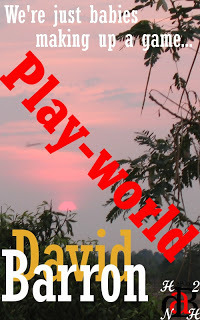
OK, have you bought it already? Pretty awesome, right? Good. Now that I can't scare you away, I'll roll into Lessons Learned Time.
This Book Took A Long Time To Get Written Down
Well, that's not technically true, in that this 20,000 word, 21 chapter short novel was written in about 15 days of basic effort (i.e. ~1200 words in a day). But those 15 days were scattered throughout a nine-month period, during which (admittedly) I wrote a whole crap-load of other, equally awesome stuff. It's not like I was thinking about the plot of this book all that time, either. I had a full bracket-outline after day 2, and it didn't change the whole time I was writing. My point is, if anybody asks me if I worked real hard on this book, I'll say "Yes!", but in the same way as I say I ran a marathon over the course of a few months, with frequent rest days and side journeys to look at cool forts.
But, I now know my "Resting word-count"
Yes, with no effort whatsoever beyond forcing myself to actually type, I write 1200 words in about 4 hours (henceforth referred to as a Writing Unit because I like making things up). Considering that a Writing Unit is about the amount of time I can make free in a day with absolutely no effort (beyond not sleeping 10 hours a night) we can call that the Resting Daily Word Count, but we don't have to.
That's pitiful, but that's not the point. I can now theoretically schedule out a book based on minimal effort. So, say I'll write a 40,000 word book next...it should be done in 34 Writing Units. This is known as "Quantified Business". Take notes.
Books are Fun to Write
Well, one would hope so. They're just longer stories, and stories are fun to write.
This Book was Fun to Write
It was cool! There was a laser! And most importantly, now that it's finished, I never have to look at again.
Until I Write the Sequel
There's a sequel?
Sure, why not?
It IS a pretty cool setting...
Anyways, this is all the promotion I'm going to do for this book. (I'm busy.) So enjoy!Available Stories


Controlling drones mapping the surface of a forgotten Earth is a pretty sweet gig, especially since Ernie Centrifuge can work from the comfort of his computer room on the floating city of Megalopolis...but when he takes a job to survey a mysterious island, he finds himself entangled in a deadly competition for a lost and priceless treasure! With the help of his sister (a psion), her husband (a pilot), and a sarcastic lady he meets in a car accident (a police inspector), Ernie races to find out who's who in a world where no one really knows what's what.
A technological thriller with a double shot of humor and romance: Play-world, a science fiction short novel by David Barron. (Smashwords) (Amazon for Kindle) (Barnes & Noble) (Other1)

OK, have you bought it already? Pretty awesome, right? Good. Now that I can't scare you away, I'll roll into Lessons Learned Time.
This Book Took A Long Time To Get Written Down
Well, that's not technically true, in that this 20,000 word, 21 chapter short novel was written in about 15 days of basic effort (i.e. ~1200 words in a day). But those 15 days were scattered throughout a nine-month period, during which (admittedly) I wrote a whole crap-load of other, equally awesome stuff. It's not like I was thinking about the plot of this book all that time, either. I had a full bracket-outline after day 2, and it didn't change the whole time I was writing. My point is, if anybody asks me if I worked real hard on this book, I'll say "Yes!", but in the same way as I say I ran a marathon over the course of a few months, with frequent rest days and side journeys to look at cool forts.
But, I now know my "Resting word-count"
Yes, with no effort whatsoever beyond forcing myself to actually type, I write 1200 words in about 4 hours (henceforth referred to as a Writing Unit because I like making things up). Considering that a Writing Unit is about the amount of time I can make free in a day with absolutely no effort (beyond not sleeping 10 hours a night) we can call that the Resting Daily Word Count, but we don't have to.
That's pitiful, but that's not the point. I can now theoretically schedule out a book based on minimal effort. So, say I'll write a 40,000 word book next...it should be done in 34 Writing Units. This is known as "Quantified Business". Take notes.
Books are Fun to Write
Well, one would hope so. They're just longer stories, and stories are fun to write.
This Book was Fun to Write
It was cool! There was a laser! And most importantly, now that it's finished, I never have to look at again.
Until I Write the Sequel
There's a sequel?
Sure, why not?
It IS a pretty cool setting...
Anyways, this is all the promotion I'm going to do for this book. (I'm busy.) So enjoy!Available Stories


Published on July 01, 2011 08:00
June 24, 2011
Refilling The Well
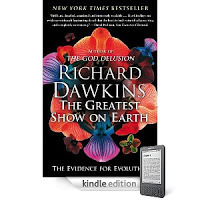 The Greatest Show on Earth
The Greatest Show on EarthRichard Dawkins
Over the weekend, my writing productivity plummeted as I sat down and read the big pile of eBooks that had been, predictably, piling up all around me. I started with this one because evolution is fun and it has pretty pictures (for which I should probably have got the hardback edition). Lots of cool writing ideas, obviously. I'm much better at biological and political SF than I am at mechanical and technical SF. Biopunk?
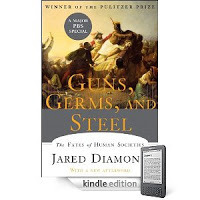 Guns, Germs, and Steel
Guns, Germs, and SteelJared Diamond
I should say anthropological SF, because that's even more fun. This book really gives me a lot of solid tools and ideas for world-building. It has also enlightened me to the point where I can never right classic Fantasy, ever. Without hanging a lampshade on everything by saying MAGIC a lot. So. Sorry? It's probably for the best. There are so many writers who are so much more qualified to write Fantasy than I am. This is an excellent source for alternate history, though. I need to write more of that.
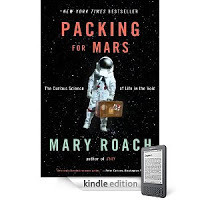 Packing for Mars
Packing for MarsMary Roach
This book was surprisingly unhelpful when it comes to the kind of SF I like to write, but it's pretty awesome nonetheless. If I ever write a 'mundane hard SF', this'll be the book I turn to for the space portions. That'd be pretty interesting, really...
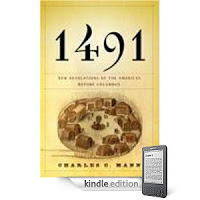 1491: New Revelations of America Before Columbus
1491: New Revelations of America Before ColumbusCharles C. Mann
Going back to anthropology by way of focusing on the interesting bits, reading this rather horrifying book about how there were whole unknown civilizations running the length of the Americas, doing their own thing and being ridiculously well-fed because they mastered the environment...and then they all pretty much died of DEATH (and also being stabbed sometimes.) Admittedly, it did encourage me to write Fantasy again, because there's a lot of mysterious stuff lying around for people to explore.
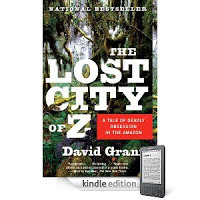 The Lost City of Z
The Lost City of ZDavid Grann
Like this. Pretty cool, eh? Some guy wanders into a jungle looking for stuff while his comrades drop like flies of horrible illnesses, interacting with tribes of Indians and getting a more dim view of the civilized world every second. Then he doesn't come back and a journalist has to find him 100 years later. Neat.
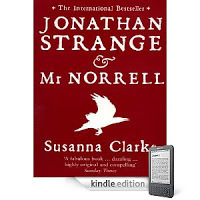 Jonathan Strange & Mr. Norrell
Jonathan Strange & Mr. NorrellSusanna Clarke
This was surprisingly good in eBook form, mostly because all the illustrations were already black and white so you didn't miss anything. Still, I'm glad I have the hardcover already. This one deserves it. Oh, and something about magic.
Back to writing, so I can get another book out on Kindle and totally link to it in one of these articles at some point.Available Stories


Published on June 24, 2011 08:00
June 17, 2011
Science Fantasy Romance

Science Fantasy Romance
What do I write? Science Fiction by consulting the Mohs Scale of Science Fiction Hardness and shooting for "Physics Plus". Usually that fails upon contact with my imagination, so I have to call it Fantasy, usually Urban Fantasy. That doesn't give my characters much to do, so they end up with some Romance, and since even wizards have sex in the future it's Paranormal Romance. Still, there's a bunch of side characters who don't have time for sex, and what do they get to do? Comedy.
So, do I write Speculative Fiction? No.
I write Science Fantasy Romance.
And now, an animated GIF that I just found in a mysterious part of my computer. It seems to fit.Available Stories


Published on June 17, 2011 08:00
June 10, 2011
To Smashwords: An Open Letter
Smashwords,
First of all, let me say: You're pretty cool. Easy distribution to a bunch of different markets, well-organized site, good accounting and payment, I get $0.59 out of $0.99? Good stuff. That's why I care about this one thing so much: Formatting for your Meatgrinder is obnoxious and my books still look kinda ugly after it all.
Let's break my problem down:
One, DOC format. I shouldn't have to own Microsoft Word in order to format an eBook. It not only complicates the process (see Two) but it also makes it more difficult for me to work on multiple computers with different operating systems (see Three). It's limiting, and unnecessarily so.
Two, Meatgrinder limitations, most egregiously 'Linked Table of Contents' & Space After Paragraphs. Creating a linked table of contents in Word is a time-consuming and annoying process fraught with peril, especially considering that properly formatted EPUB and MOBI files will create one automatically (see Three). Then there's the matter of restrictive formatting: I read a lot of eBooks while preparing to format my own, and the ones that looked best (to my taste) had indented paragraphs and a little (.2em) space after each paragraph for easier reading. When I put that space into the DOC for Meatgrinder, it rejects it for Premium Distribution. This makes my product look bad, unnecessarily, and I'm tired of dealing with Premium Distribution errors.
Three, HTML. It takes 15 minutes to format an eBook from plain-text into HTML, and that eBook will convert, via Calibre, to pretty much any format and look good doing it (and have a Linked Table of Contents appended in EPUB and MOBI, the two main formats). Doing it via the Smashwords Style Guide takes much longer, especially considering creating a Linked Table of Contents.
Four, Pictures. All those combined means that there is no way that I would ever put pictures in a file going to Smashwords, unless it was only for PDF distribution. Which is, again, unnecessarily limiting.
Solution (for you):
First of all, I love that you've focused on expanding distribution channels! Keep it up, that's one half of your selling point. But I need you to upgrade focus on upgrading your Meatgrinder to accept HTML (or at least EPUB) and convert it from that file. Let people continue submitting via DOC if you want, but let those what can handle it submit via a method that's both more convenient to prepare and looks more professional.
Solution (for me):
All this really only applies to longer fiction where more complicated formatting is necessary. I'll certainly still use Smashwords for short story distribution. I write a lot of short stories and I sell lots of short stories through your distribution networks, so you earn your 10% there (and I get more than the Amazon 35% Great!) But! Until Meatgrinder is upgraded, I'll upload my books (and short story collections) directly to my three focus sites: Amazon, B&N, and Kobo, so that I can be sure of my formatting and the quality of my product.
Thanks for your time,
David Barron
feel free to commentAvailable Stories


First of all, let me say: You're pretty cool. Easy distribution to a bunch of different markets, well-organized site, good accounting and payment, I get $0.59 out of $0.99? Good stuff. That's why I care about this one thing so much: Formatting for your Meatgrinder is obnoxious and my books still look kinda ugly after it all.
Let's break my problem down:
One, DOC format. I shouldn't have to own Microsoft Word in order to format an eBook. It not only complicates the process (see Two) but it also makes it more difficult for me to work on multiple computers with different operating systems (see Three). It's limiting, and unnecessarily so.
Two, Meatgrinder limitations, most egregiously 'Linked Table of Contents' & Space After Paragraphs. Creating a linked table of contents in Word is a time-consuming and annoying process fraught with peril, especially considering that properly formatted EPUB and MOBI files will create one automatically (see Three). Then there's the matter of restrictive formatting: I read a lot of eBooks while preparing to format my own, and the ones that looked best (to my taste) had indented paragraphs and a little (.2em) space after each paragraph for easier reading. When I put that space into the DOC for Meatgrinder, it rejects it for Premium Distribution. This makes my product look bad, unnecessarily, and I'm tired of dealing with Premium Distribution errors.
Three, HTML. It takes 15 minutes to format an eBook from plain-text into HTML, and that eBook will convert, via Calibre, to pretty much any format and look good doing it (and have a Linked Table of Contents appended in EPUB and MOBI, the two main formats). Doing it via the Smashwords Style Guide takes much longer, especially considering creating a Linked Table of Contents.
Four, Pictures. All those combined means that there is no way that I would ever put pictures in a file going to Smashwords, unless it was only for PDF distribution. Which is, again, unnecessarily limiting.
Solution (for you):
First of all, I love that you've focused on expanding distribution channels! Keep it up, that's one half of your selling point. But I need you to upgrade focus on upgrading your Meatgrinder to accept HTML (or at least EPUB) and convert it from that file. Let people continue submitting via DOC if you want, but let those what can handle it submit via a method that's both more convenient to prepare and looks more professional.
Solution (for me):
All this really only applies to longer fiction where more complicated formatting is necessary. I'll certainly still use Smashwords for short story distribution. I write a lot of short stories and I sell lots of short stories through your distribution networks, so you earn your 10% there (and I get more than the Amazon 35% Great!) But! Until Meatgrinder is upgraded, I'll upload my books (and short story collections) directly to my three focus sites: Amazon, B&N, and Kobo, so that I can be sure of my formatting and the quality of my product.
Thanks for your time,
David Barron
feel free to commentAvailable Stories


Published on June 10, 2011 08:00
June 6, 2011
ebook Formatting Workflow
Since I've trial'd and error'd it out for myself, and it's not that difficult, here's the Official David Barron eBook Formatting Workflow! Note that it doesn't include how to do images, because I haven't tried that yet. It's also pretty bare-bones, but you can probably figure it out... (This doesn't count as my Friday article) If you totally want to hire me to format an eBook, first, seek professional help because you're insane, then give me $50 and I'll do it, I guess. Free money, am I right? (This takes...15 minutes.)
eBook Formatting
Programs
FocusWriter for text
Microsoft Word 2007 for DOC and pre-formatting
jEdit for HTML
calibre for conversion to EPUB and MOBI
GIMP for cover art
Kindle Previewer
FocusWriter text
type, use -- for — (em dash)
Microsoft Word 2007 preformatting
double quotes : " with "
single quotes : ' with '
em dash : -- with —
ellipses : ... with …
Ctrl-i to <i>^&</i>
jEdit entities
paragraphs: ^(.+)$ with <p>$1</p>
search for <p></i> and fix
" with ”
" with “
' with ‘
' with ’
… with …
— with —
è with è
é with é
Bold with <strong>Bold</strong>
Strikethrough with <del>Strikethrough</del>
jEdit styles
Apply this header, wrap with body tags
Book Chapters/Collection Stories =
<p class="chapter">Chapter Title</p>
Individual Short Story 'chapter' (for clean ToC) =
<p class="chapter" style="display:none">Short Story Title</p>
<p class="story">First paragraph of text</p>
Apply other styles
*** with <p class="centered"><span class="centered">***</span></p>
Search for & in browser window, then manually replace & with & in jEdit
Calibre conversion
Add HTML to Calibre, edit metadata, add cover
Convert to EPUB
Table of Contents
Level 1 TOC (XPath Expression) = //h:p[re:test(@class, "chapter", "i")]
EPUB Output
check 'Preserve cover aspect ratio'
Convert to MOBI
Check DOC in Word 2007, upload to Smashwords
Check MOBI in Kindle Previewer, Upload to Amazon KDP
Check EPUB in calibre, Upload to Others
Samples
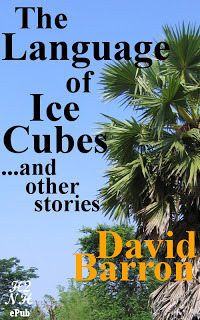
Collection
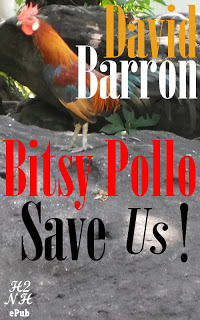
Short Story
Available Stories


eBook Formatting
Programs
FocusWriter for text
Microsoft Word 2007 for DOC and pre-formatting
jEdit for HTML
calibre for conversion to EPUB and MOBI
GIMP for cover art
Kindle Previewer
FocusWriter text
type, use -- for — (em dash)
Microsoft Word 2007 preformatting
double quotes : " with "
single quotes : ' with '
em dash : -- with —
ellipses : ... with …
Ctrl-i to <i>^&</i>
jEdit entities
paragraphs: ^(.+)$ with <p>$1</p>
search for <p></i> and fix
" with ”
" with “
' with ‘
' with ’
… with …
— with —
è with è
é with é
Bold with <strong>Bold</strong>
Strikethrough with <del>Strikethrough</del>
jEdit styles
Apply this header, wrap with body tags
<?xml version="1.0" encoding="utf-8"?>
<!DOCTYPE html PUBLIC "-//W3C//DTD XHTML 1.0 Strict//EN" "http://www.w3.org/TR/xhtml1/DTD/xhtml...
<head>
<style type="text/css">
html, body, div, h1, h2, h3, h4, h5, h6, ul, ol, dl, li, dt, dd, p, pre, table, th, td, tr { margin: 0; padding: 0em; }
p
{
text-indent: 1.5em;
margin-bottom: 0.2em;
}
p.noindent
{
text-indent: 0em;
margin-bottom: 0.2em;
}
p.preview
{
margin-top: 5em;
margin-bottom: 2em;
}
p.title
{
page-break-before: always;
font-size: 3em;
font-weight: bold;
margin-top: 5em;
}
p.subtitle
{
text-indent: 3em;
font-size: 2em;
font-weight: bold;
}
p.author
{
text-indent: 3em;
font-size: 2em;
}
p.matter
{
text-indent: 3em;
font-size: 1.5em;
}
p.chapter
{
page-break-before: always;
text-indent: 1.5em;
font-weight: bold;
font-size: 2em;
margin-top:5em;
margin-bottom:2em;
}
p.story
{
text-indent: 1.5em;
font-size: 1em;
margin-top: 5em;
margin-bottom: 0.2em;
}
p.centered
{
text-indent: 0em;
text-align: center;
}
span.centered
{
text-indent: 0em;
text-align: center;
}
</style>
</head>
<body>
</body>
Book Chapters/Collection Stories =
<p class="chapter">Chapter Title</p>
Individual Short Story 'chapter' (for clean ToC) =
<p class="chapter" style="display:none">Short Story Title</p>
<p class="story">First paragraph of text</p>
Apply other styles
*** with <p class="centered"><span class="centered">***</span></p>
Search for & in browser window, then manually replace & with & in jEdit
Calibre conversion
Add HTML to Calibre, edit metadata, add cover
Convert to EPUB
Table of Contents
Level 1 TOC (XPath Expression) = //h:p[re:test(@class, "chapter", "i")]
EPUB Output
check 'Preserve cover aspect ratio'
Convert to MOBI
Check DOC in Word 2007, upload to Smashwords
Check MOBI in Kindle Previewer, Upload to Amazon KDP
Check EPUB in calibre, Upload to Others
Samples

Collection

Short Story
Available Stories


Published on June 06, 2011 19:24
June 3, 2011
Sexy eBooks
I finally formatted an eBook up the right way, and I just want to lay out what I did. My main text was Guido Henkel's Take Pride in Your eBook Formatting and I don't intend to repeat any of it. Consult that guide,just consider this a personalized companion article as well as a guide to people who are using jEdit to follow that series because they don't own a Mac. Your Mileage May Vary, I'm just muddling through while taking notes. If you want somebody to design your ebook for you, send Guido Henkel an e-mail. (Don't ask me.)
I don't really feel like waiting until Friday to post it. It still counts as my Friday article for this week, because it's really freakin' long, OK? Let's just jump into the freezing water.
UPDATE: I've formatted two more eBooks since I wrote this, so I'm updating the workflow to reflect what I actually do. I'll update the actual HTML head later, because I'm narrowing in on a universally useful one for my purposes.
Programs you will need:
Microsoft Word 2007
or the word processor of your choice. If you're on Linux, you can use OpenOffice.
jEdit
Calibre
you should have this already if you own or publish eBooks. Get it now.
Workflow
Word 2007
Make all the paragraphs, italics, and punctuation that you want, make sure the smart quotes and other auto-replace options are on and Find and Replace:
double quotes : " with "
single quotes : ' with '
em dash : -- with —
ellipses : ... with …
Just replace them with themselves and this will transform them into the appropriate special characters, and you won't have to think about changing all the straight quotes into curly quotes. Easy. If it doesn't happen, make sure the appropriate AutoFormat options are on in Word.
If you have a bunch of italics scattered through your text, do this!
italics : Ctrl-i to <i>^&</i>
Warning, when I did this, and there was a </i> at the end of the paragraph, when I later ran <p>$1</p> (see below) it put the </p> before the </i> and sent that to the start of the next paragraph. So, in addition to the jEdit stuff below, search for </i> and make sure your tags are closed.
jEdit Cleaning
Copy and paste your text into jEdit. Good. Now we want to put in our paragraph tags, so go to Search - Find, check the 'Regular Expressions' box, and Find and Replace like so:
paragraphs: ^(.+)$ with <p>$1</p>
Sexy. Now, save it as an html file. And make a backup for when you screw up. Then, if you took Option 1, you'll want to do all these Find and Replace
(DO NOT do & with & at this time!)
" with “
" with ”
' with ‘
' with ’
… with …
— with —
Bold with <strong>Bold</strong>
In mine, I had these things too, so I assume you might too:
è with è
é with é
Strikethrough
: <del>Strikethrough</del>
Good times, but now we have to make it look pretty.
jEdit Styles
Go Here for super details from Guido Henkel, so I'll just put the head I eventually cobbled together for a collection of short stories. (Feel free to steal it, if you can, but it's easy enough to make your own.)
Put </body> at the end of the html file.
Now we can put the appropriate chapter styles in (in this case, the title is "The Littlest Barnacle"):
<p class="chapter">The Littlest Barnacle</p>
We can find and replace our section dividers (replace *** below with whatever you happen to use):
*** with <p class="centered"><span class="centered">***</span></p>
Sprinkle the html file with the other appropriate style tags. Mostly I used "noindent" to remove the indentation for some paragraphs, but I also formatted the front and back matter to taste.
Finally I opened the saved html in a browser window and searched for &, then manually found it in jEdit and replaced:
& with &
I only had three in the whole eBook, so it didn't take long.
So, now if you didn't do anything wrong, you have a sexy html to convert to various eBook formats. Thus:
Calibre
Go Here (Part IX of Take Pride in Your eBook Formatting), Do That. Basically, in Level 1 TOC (XPath Expression) add:
//h:p[re:test(@class, "chapter", "i")]
I don't have anything to add, except to note that when it converts to MOBI, it will add a linked table of contents to the end of the ebook, so don't bother to put one in yourself. As for my actual html, I claim no special expertise, so if you spot any stupid errors, shout out!
Now put that MOBI up on Kindle and use the EPUB wherever they'll take it. It'll be pretty. Comment below with a link when you do, then consider joining me as I try to get Smashwords to take my pretty EPUB (or even PDF) instead of my utilitarian DOC.
Conclusion
And but so: check out my newest short story collection on Amazon. Preview it. It looks pretty damn good!
A Future Darkly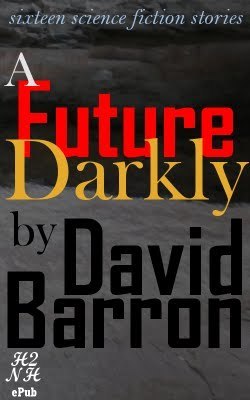 Available Stories
Available Stories


I don't really feel like waiting until Friday to post it. It still counts as my Friday article for this week, because it's really freakin' long, OK? Let's just jump into the freezing water.
UPDATE: I've formatted two more eBooks since I wrote this, so I'm updating the workflow to reflect what I actually do. I'll update the actual HTML head later, because I'm narrowing in on a universally useful one for my purposes.
Programs you will need:
Microsoft Word 2007
or the word processor of your choice. If you're on Linux, you can use OpenOffice.
jEdit
Calibre
you should have this already if you own or publish eBooks. Get it now.
Workflow
Word 2007
Make all the paragraphs, italics, and punctuation that you want, make sure the smart quotes and other auto-replace options are on and Find and Replace:
double quotes : " with "
single quotes : ' with '
em dash : -- with —
ellipses : ... with …
Just replace them with themselves and this will transform them into the appropriate special characters, and you won't have to think about changing all the straight quotes into curly quotes. Easy. If it doesn't happen, make sure the appropriate AutoFormat options are on in Word.
If you have a bunch of italics scattered through your text, do this!
italics : Ctrl-i to <i>^&</i>
Warning, when I did this, and there was a </i> at the end of the paragraph, when I later ran <p>$1</p> (see below) it put the </p> before the </i> and sent that to the start of the next paragraph. So, in addition to the jEdit stuff below, search for </i> and make sure your tags are closed.
jEdit Cleaning
Copy and paste your text into jEdit. Good. Now we want to put in our paragraph tags, so go to Search - Find, check the 'Regular Expressions' box, and Find and Replace like so:
paragraphs: ^(.+)$ with <p>$1</p>
Sexy. Now, save it as an html file. And make a backup for when you screw up. Then, if you took Option 1, you'll want to do all these Find and Replace
(DO NOT do & with & at this time!)
" with “
" with ”
' with ‘
' with ’
… with …
— with —
Bold with <strong>Bold</strong>
In mine, I had these things too, so I assume you might too:
è with è
é with é
Strikethrough
: <del>Strikethrough</del>
Good times, but now we have to make it look pretty.
jEdit Styles
Go Here for super details from Guido Henkel, so I'll just put the head I eventually cobbled together for a collection of short stories. (Feel free to steal it, if you can, but it's easy enough to make your own.)
<?xml version="1.0" encoding="utf-8"?>
<!DOCTYPE html PUBLIC "-//W3C//DTD XHTML 1.0 Strict//EN" "http://www.w3.org/TR/xhtml1/DTD/xhtml...
<head>
<style type="text/css">
html, body, div, h1, h2, h3, h4, h5, h6, ul, ol, dl, li, dt, dd, p, pre, table, th, td, tr { margin: 0; padding: 0em; }
p
{
text-indent: 1.5em;
margin-bottom: 0.2em;
}
p.noindent
{
text-indent: 0em;
margin-bottom: 0.2em;
}
p.title
{
font-size: 3em;
font-weight: bold;
margin-top: 5em;
}
p.front
{
text-indent: 3em;
font-size: 2em;
}
p.chapter
{
page-break-before: always;
text-indent: 1.5em;
font-weight: bold;
font-size: 2em;
margin-top:5em;
margin-bottom:2em;
}
p.centered
{
text-indent: 0em;
text-align: center;
}
span.centered
{
text-indent: 0em;
text-align: center;
}
</style>
</head>
<body>
Put </body> at the end of the html file.
Now we can put the appropriate chapter styles in (in this case, the title is "The Littlest Barnacle"):
<p class="chapter">The Littlest Barnacle</p>
We can find and replace our section dividers (replace *** below with whatever you happen to use):
*** with <p class="centered"><span class="centered">***</span></p>
Sprinkle the html file with the other appropriate style tags. Mostly I used "noindent" to remove the indentation for some paragraphs, but I also formatted the front and back matter to taste.
Finally I opened the saved html in a browser window and searched for &, then manually found it in jEdit and replaced:
& with &
I only had three in the whole eBook, so it didn't take long.
So, now if you didn't do anything wrong, you have a sexy html to convert to various eBook formats. Thus:
Calibre
Go Here (Part IX of Take Pride in Your eBook Formatting), Do That. Basically, in Level 1 TOC (XPath Expression) add:
//h:p[re:test(@class, "chapter", "i")]
I don't have anything to add, except to note that when it converts to MOBI, it will add a linked table of contents to the end of the ebook, so don't bother to put one in yourself. As for my actual html, I claim no special expertise, so if you spot any stupid errors, shout out!
Now put that MOBI up on Kindle and use the EPUB wherever they'll take it. It'll be pretty. Comment below with a link when you do, then consider joining me as I try to get Smashwords to take my pretty EPUB (or even PDF) instead of my utilitarian DOC.
Conclusion
And but so: check out my newest short story collection on Amazon. Preview it. It looks pretty damn good!
A Future Darkly
 Available Stories
Available Stories

Published on June 03, 2011 08:00



